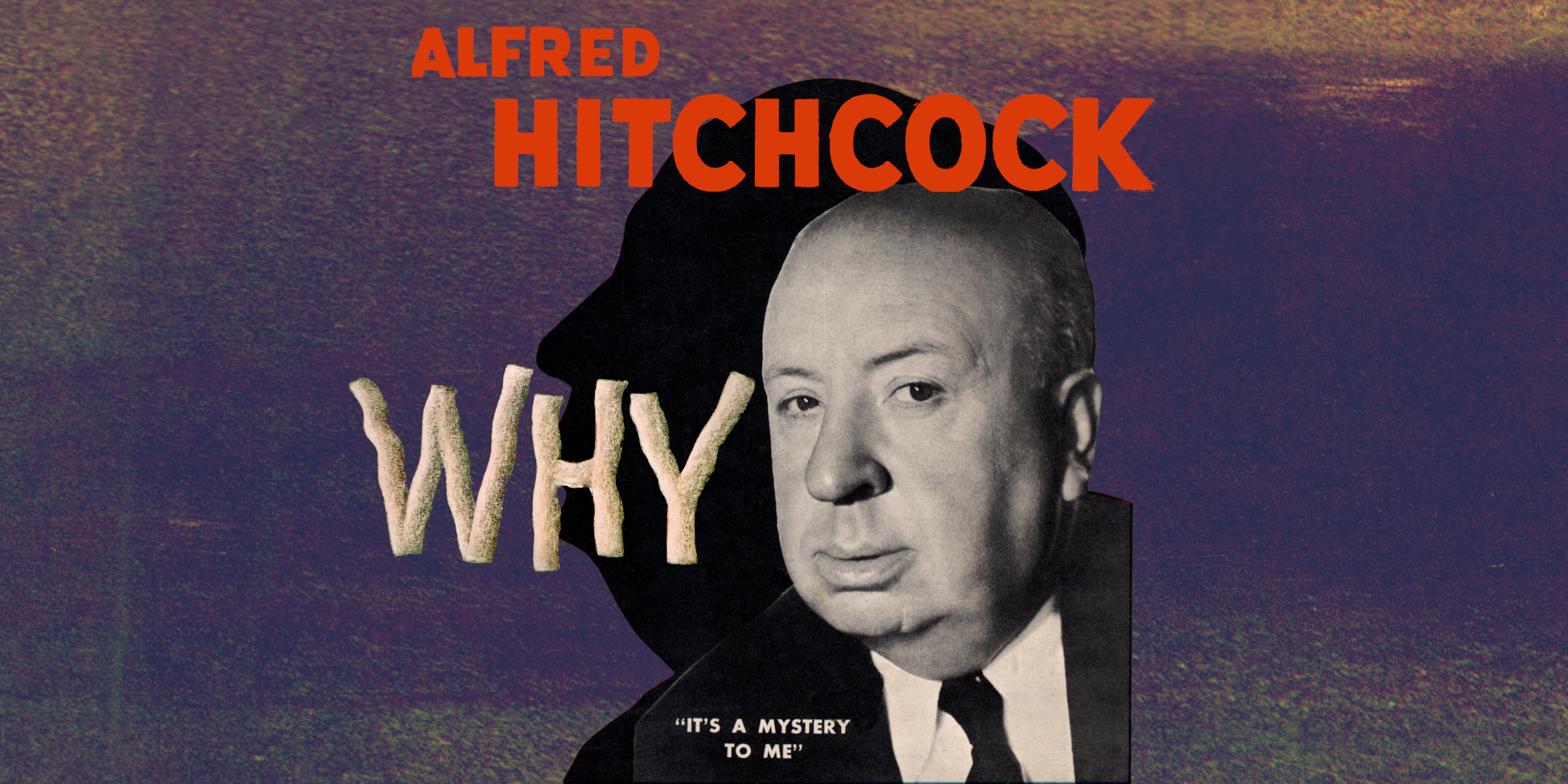I love Alfred Hitchcock, and while my ten favorite films change on a nearly daily basis, you can guarantee that Psycho, The 39 Steps, and North by Northwest will always be somewhere on the list.
So, when I learned there was an official Alfred Hitchcock board game, I was very excited, my mind filled with images of intense horror games and twisting thrillers. Alas, 1958’s Alfred Hitchcock Presents Why isn’t either of those. Instead, it’s a unique take on Clue (or Cluedo if you’re a Brit).
How To Play Why

The game’s premise is pretty simple, Alfred Hitchcock has asked a group of Private Eyes to visit his house. Alfred has invited them because his house is haunted by the ghosts of several people who went missing after attending a masquerade ball many years previously, and he’s hoping the detectives can figure out how the ghosts died and thus get rid of them.
Setting up the game is pretty easy as it only uses the board, a deck of cards, and a dice. At the start of the game, each player is given 7 cards. Each card contains either part of a ghost, part of a murder weapon, a motive, part of Hitchcock’s silhouette, No Clue, or It’s a Mystery To Me. Then, all the player pieces are put in the Living Room part of the board. The remaining cards are then shuffled and split into six piles, one for each room on the board.
On their turn, the player rolls the dice and moves around the board. If a player ends their turn in a room, they draw the top card from that room’s pile. Players can only hold 7 cards, so when they get a new one, they either discard the one they just got or remove a card from their hand. Interestingly, when you discard a card, you don’t simply get rid of it. Instead, the player must show the card to all other players before placing it face down somewhere off the board (an area dubbed”The Lawn” in the rules).
But this isn’t the only way for players to get cards. When two people end up in the same square or room, the player who arrived second may show the other player part of a set they have. If the other player has another card from the set, they must hand it over. If the first player asks for a card the second doesn’t have, the second can request a card from the first. However, if the second player has a “No Clue” card, they may hand that over instead. If the second player does that, the first must give the second a random card from their hand.
Another way to get cards is to take them from the Lawn. When a player is in the living room, they may show the other players part of a set they have. They may then point to a card on the Lawn and declare it is part of the same set. The card is then turned over. If the player is correct, then they get to take the card and put one card from their hand face-down on the Lawn.
Once this is done, the player may decide to either end their turn or repeat this process, and a player can keep taking cards from the Lawn until they make an incorrect guess. When the player makes an incorrect guess, they must take the card they selected and put the card they showed everyone on the Lawn before ending their turn.
A player wins the game when they solve the crime by collecting a complete ghost set, murder weapon set, and a motive card. Alternatively, a player can win by collecting all six Alfred Hitchcock silhouette cards and the “It’s a Mystery To Me” card.
While this may all seem complex on paper, the game is very intuitive during play, leading to a fast and fluid gameplay experience. At first, it’s easy to see this game as a blatant attempt to jump on the Clue bandwagon. But as you play, you’ll notice that Alfred Hitchcock Presents Why’s mechanics lead to a vastly different, and arguably superior, gameplay experience.
Alfred Hitchcock Presents Why Still Holds Up Today

Being able to take cards from other players makes moving around the house an actual mechanic rather than something that exists to pad out gameplay. As many mechanics force people to reveal which cards they have in their hand, players will quickly start hunting down the ones with the cards they want. Thus, players who want to win must move carefully to prevent their cards from getting stolen by other players. Doubly so because the board features several crossroads, making it easy to get ambushed.
The Lawn also dramatically enhances the game, massively elevating the social deduction aspects. Cards added to the Lawn are not shuffled or rearranged after being added, meaning keeping track of which cards are on the Lawn and where they are is crucial to victory. Plus, as a player can keep drawing from the Lawn several times in one turn, it is feasible for a canny player to get a winning hand from Lawn draws alone, adding a lot of strategy to the gameplay.
Plus, due to how the Lawn works, a player can deliberately make a wrong guess to get their hands on a card, even if they don’t have any others from that set. You can do this to block another player’s victory or quickly refocus your efforts if you’re unsure where the cards you want are. Interestingly, this technique is mentioned in the game’s extra rules section, meaning that this is a deliberate piece of design rather than a cheeky exploit.
This all comes together to make an exciting social deduction game that rewards canny play and players who pay attention to the details. But, while it does allow high-level play, the game is still very accessible, meaning that players who don’t enjoy directly messing with others will still be able to play and stand a good chance of winning.
Alfred Hitchcock Presents Why also has some delightfully pretty artwork with the haunted house-themed board perfectly evoking the feeling of classic Victorian horror. The art for the various ghosts is also rather charming, though it is let down by its use of First Nations and Asian stereotypes.
At first, I was slightly disappointed with Alfred Hitchcock Presents Why, as it doesn’t really capture the feeling or intensity of Hitchcock’s work or the creativity and tone of the Alfred Hitchcock Presents television show it was meant to tie in with.
But after playing it a few times, I fell in love with the game. Its social deduction mechanics are expertly designed, leading to many fun gambits and double-crosses during play. If this game came out today (with updated art), I could easily see it becoming a cult hit with casual and hardcore board gamers alike due to simple-to-learn mechanics and the pure chaos it inspires.


